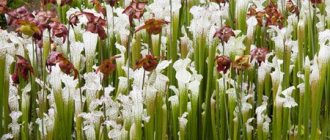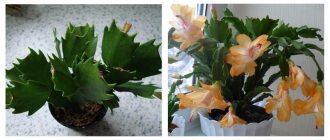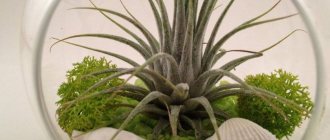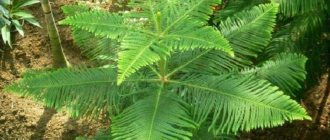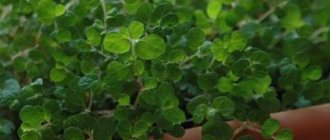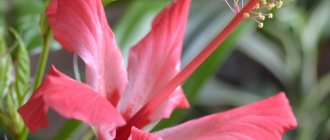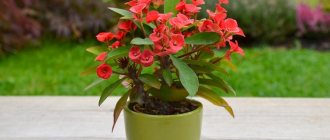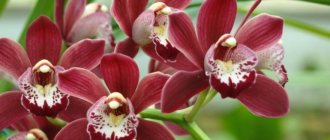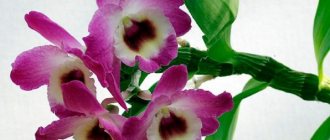This indoor flower belongs to the Gesneriaceae family and is a relative of such famous plants as Saintpaulia (violets) and gloxinia. Achimenes come in both erect (this form is also often called “bush”) and hanging. The leaves of these plants are usually slightly pubescent, and are somewhat reminiscent of nettles in shape and feel. It is for their similarities that these plants are sometimes compared. The second well-known name is “friendly family”. It comes from the propagation method of achimenes (rhizomes), which, if not planted, will sprout next year in a friendly group. Achimenes are winning more and more hearts of passionate gardeners, and this is no coincidence - the flowering bushes of Achimenes are simply wonderful! Admire how the Achimenes bloom in my collection:
It can rightfully be said that these flowers combine all the best characteristics of many popular indoor plants. Let's take a closer look at why they are so good!
Peculiarities
Achimenes is a small shrub or hanging plant with straight herbaceous shoots . The leaves are about 5–7 cm long, oval in shape with jagged edges and a sharp tip. Their main color is green, and the lower surface may have a reddish tint.
The flowers are large, from 5 to 10 cm depending on the variety, shaped like bells with open petals. The shades are very diverse : from bright purples and reds to muted pastel tones.
Many variegated varieties have also been developed - their corollas have a contrasting core or multi-colored specks on the petals.
The root system is represented by a thickened rhizome - a rhizome, from which roots branch. As the flower grows, daughter shoots are formed on it, which are used for reproduction.
Achimenes is considered a perennial crop, but after flowering the above-ground part dries out completely, leaving only the underground rhizome a. This is the so-called dormant phase of the plant: in the spring, with sufficient light, young shoots appear again.
Description
The stems are well branched, drooping or erect. The pubescent leaves have jagged edges and are soft to the touch. Elongated flowers in the form of bells are located throughout the bush. They have a bright color. Large flowers can be of a wide variety of shades; there are even striped or spotted ones.
The flowering period lasts a long time, the flowers quickly wither and fall off, and are replaced by new ones. As a rule, they bloom 2 times per season. The second flowering is not as bright and abundant as the first.
Achimenes flowering
The buds begin to form in late spring and bloom in June. Flowering is characterized by an undulating flow: some flowers gradually fade, while others bloom .
This continues until September-October, when due to lack of light and heat the plant enters the dormant phase. Important! Such time intervals are typical for Achimenes, whose rhizomes are planted in late February - early March.
If the planting dates are shifted, then flowering will begin later. The shrub is characterized by abundant flowering, when the entire plant is covered with an almost continuous carpet of flowers. If the buds can be counted on one hand, then most likely there were errors in the content:
- Fertilizers contain excess nitrogen, which only stimulates foliage growth. It is required to switch to fertilizing with potassium and phosphorus a month before the expected flowering.
- The green pet lacks sunlight.
- Rhizomes are planted in the ground late.
- The plant has suffered from a disease, most often of a fungal nature.
Types of Achimenes domestica with photos and names
Surprisingly, all varieties (with descriptions and photos) of Achimenes are obtained from only 2 main species - large-flowered and long-flowered.
Achimenes grandiflora
The height of the crop usually does not exceed 60 cm. The leaves are pubescent, with teeth along the edges, green on the outside and burgundy on the inside. In the axil of the leaf, 2 red flowers are formed at once.
Long-flowered Achimenes (Achimenes longiflora)
The height of the bush is 2 times less than that of the previous species. The shoots, like the leaves, are pubescent and do not branch. Achimenes longiflora forms 1 purple bud in the axils with a corolla up to 5 cm.
Do you want to get your first achimenes or add to your collection?
For readers of this article, we have prepared a gift - free delivery of orders using coupon 4545. Choose varieties and place your order:
Nocturne
200 rub.
Article: 150 Nocturne ("Nocturne") Gorgeous, very dark shade... Add to cart
Add to Wishlist
Product added! Go to wishlist
The product is already in the wishlist Go to wishlist
Pulcherrima
80 rub.
Article: 177Out of stock Pulcherrima (“Pulkerima”) From the Latin name of this ... Read more
Add to Wishlist
Product added! Go to wishlist
The product is already in the wishlist Go to wishlist
DiscountDouble Pink Rose
300 rub.
250 rub. Article: 68Out of stock Double Pink Rose (“Double Pink… Read more
Add to Wishlist
Product added! Go to wishlist
The product is already in the wishlist Go to wishlist
Simbirochka
180 rub.
Article: 214Out of stock Simbirochka (“Simbirochka”) Ruddy hybrid with large ... Read more
Add to Wishlist
Product added! Go to wishlist
The product is already in the wishlist Go to wishlist
Ambroise Verschaffelt
250 rub.
Article: 6 Ambroise Verschaffelt (Ambroise Vershafelt) Named in ... Add to cart
Add to Wishlist
Product added! Go to wishlist
The product is already in the wishlist Go to wishlist
1 review
5.00 out of 5
Glory
140 rub.
Article: 91 Out of stock Glory Compact and at the same time very ... Read more
Add to Wishlist
Product added! Go to wishlist
The product is already in the wishlist Go to wishlist
Snoweetta
200 rub.
Article: 217 Out of stock Achimenec Snowetta (“Snowita”) Very attractive and unpretentious… Read more
Add to Wishlist
Product added! Go to wishlist
The product is already in the wishlist Go to wishlist
Juaregia
150 rub.
Article: 120Out of stock Juaregia (“Georgia”) White ampel with large ... Read more
Add to Wishlist
Product added! Go to wishlist
The product is already in the wishlist Go to wishlist
1 review
5.00 out of 5
Nero
250 rub.
Article: 149 Nero Adorable miniature terry achimenes... Add to cart
Add to Wishlist
Product added! Go to wishlist
The product is already in the wishlist Go to wishlist
Petite Fadette
250 rub.
Article: 165 Petite Fadette (“Petite Fadette”) Variety name ... Add to cart
Add to Wishlist
Product added! Go to wishlist
The product is already in the wishlist Go to wishlist
DiscountDot
220 rub.
150 rub. Article: 65 Dot Hybrid - a classic of the collections! … Add to cart
Add to Wishlist
Product added! Go to wishlist
The product is already in the wishlist Go to wishlist
Caring for Achimenes
In order for Achimenes to bloom on time and abundantly, they require suitable conditions and good care.
Lighting
The best location for achimenes will be a western or eastern window . In the south, it is better to shade the leaves from the sun during the daytime.
In the northern part of the house or in the back of the room, the shoots will quickly stretch out from lack of light, and flowering may be completely absent.
Temperature
Its heat-loving nature is reflected even in its name: from Greek “ahimenes” is translated as “afraid of the cold.” But the flower does not like heat either: the optimal temperature in summer is considered to be 20...22 °C.
At temperatures above 27 °C, the condition of the corollas worsens, they become smaller and change their color.
In winter, rhizomes are stored at a temperature no higher than 15 °C.
View this post on Instagram
Posted by Indoor Flowers and Plants (@pro_flowers74) Jul 28, 2019 at 7:24 PDT
Priming
For fast-growing and abundantly flowering achimenes, soil nutrition is important. The soil must be well permeable to air and have a slightly acidic reaction .
Of the ready-made substrates, the composition for Saintpaulia has suitable characteristics, which can be supplemented with pieces of coal, moss and brick chips.
When preparing the soil yourself, you need to mix sand, peat and humus in equal volumes and add the same amount of leaf soil.
Before planting rhizomes, the soil is heated in the oven or frozen in the freezer to destroy pathogenic microorganisms and fungi.
Achimenes pot
The main part of the roots of Achimenes is located superficially, so the pot for the flower is chosen wide and shallow . For hanging varieties, any flower pot that is hung against the wall or placed on a high shelf is suitable.
The material of the pot can be anything, the main thing is that there are wide drainage holes at the bottom to quickly drain excess water.
View this post on Instagram
Posted by Indoor Flowers and Plants (@pro_flowers74) Aug 6, 2019 at 5:11 PDT
Watering
Achimenes should be watered regularly, especially in the summer when there are an abundance of flowers. At least once every 3 days, moisten the soil with well-settled water slightly warmer than room temperature. Watering is carried out early in the morning or after sunset .
It is important to ensure that water does not get on the delicate leaves. If this happens, the drops are immediately blotted with a paper napkin.
Feeding
Achimenes need constant feeding to survive. From the moment the rhizome germinates, liquid fertilizers for Gesneriaceae or any universal remedy for indoor plants are applied at least 3 times a month.
Until mid-spring, you can add fertilizers with a predominance of nitrogen , which will accelerate the growth of green mass. By summer, you need a mineral complex with potassium and phosphorus. Ready-made fertilizers for flowering plants are usually sold with this composition.
During flowering, the amount of fertilizing increases to weekly.
Advice! Experienced gardeners recommend adding fertilizer in a minimal dose during each watering, which results in even more luxuriant flowering.
Transfer
In order for the flower to have enough nutrition for the new season, it is recommended to transplant the rhizomes into a new substrate after wintering:
- In February, the rhizomes are removed from the soil and cleaned of damaged parts.
- You can use the same pot, cleaned and rinsed well with boiling water, or take a new one. Cover the bottom with drainage.
- Cover with soil almost to the top, leaving 5 cm free to the top edge of the container.
- Water and place the rhizomes horizontally, using slight pressure to deepen them by half a centimeter.
- Pour another 1–1.5 cm of soil on top and spray with a spray bottle.
The pot is placed in light at a temperature of 25 °C. Sprouts begin to appear after 2 weeks.
How to prune achimenes
In order for Achimenes to bloom profusely, the bush must be formed by lateral branches . This is achieved by spring pruning: it begins with the formation of the very first shoots.
Pinching the tops of the main branches gives impetus to the growth of secondary ones, where the buds will be formed.
Important! The last pruning is carried out in May, when flowers begin to form.
Achimenes in winter: dormant period
The dormant period begins gradually in October, when all the buds fall off and the shoots dry out. It is important to let this process complete on its own and not cut off any green branches.
During drying, the rhizomes gain strength for wintering from the above-ground part , and they can also catch an infection from bare stumps.
Already dry branches are removed, the pot is moved to a cool, dark place for the whole winter. There is no need to water it, just spray it with a spray bottle about once a month.
At the same time, the ground should be inspected for the presence of fungus and, if necessary, sprayed with a fungicidal preparation .
The dormant period can last up to six months if the air temperature remains low and fungus does not appear.
You need to put the pot back on the windowsill no earlier than mid-February, when the roots appear again and the flower begins to grow.
Problems in growing Achimenes
In the process of caring for the Achimenes flower at home, certain difficulties arise:
- The plant sheds buds and leaves. Hot, dry air can provoke this phenomenon. If the leaves simply wilt, the cause is often insufficient moisture.
- The tips of the leaves dry out. Perhaps the flower is exposed to direct sunlight for a long period. Contact with cold water on the plant can cause spotting.
- The flower grows slowly. The reasons are often poor lighting, drafts, heavy soil.
Serious problems when growing crops are Achimenes diseases. The plant may be susceptible to fungal diseases. It is necessary to remove damaged areas of pagons and leaves, and treat the soil with a fungicide.
When aphids and spider mites appear, insecticides are used.
How to dig up rhizomes and prepare for storage
It is not necessary to leave the rhizomes to overwinter in a pot: they can be dug up and compactly stored in a bag.
To do this, use a garden shovel to carefully dig up the soil from the edges and pull out the rhizomes with your hands. They need to be cleaned of roots and damaged parts, dried a little at room temperature.
Rhizomes are stored in bags filled with sand or peat . To prevent mold from forming over the winter, antifungal powder for indoor flowers is added to the substrate and mixed well.
Diseases and pests
Possible problems that you may encounter when growing Achimenes, their causes and solutions:
- The buds turn brown . This happens if you keep the plant at too high a temperature (from +26 ° C and above). Lower the temperature and the problem will go away.
- Brown spots appear on the surface of the leaf . A common cause is watering with cold water. It is better to water the plant with water at room temperature or even lukewarm.
- A gray coating appears on the leaves and buds of Achimenes, they shrink and die . This happens when a flower is damaged by gray rot. This is a fungal disease that develops when water stagnates in a pot. You can avoid it if you water the plant only after the soil has dried. Treatment consists of removing the affected parts of the bush, as well as treating it with a 0.2% solution of Fundazol or another fungicide.
The following pests may appear on the Achimenes bush:
- Thrips . Small dried spots appear on the leaves, and colorless scars appear on the petals. Buds and young shoots become deformed, leaves turn yellow.
- Spider mite . Symptoms of damage are the same as when thrips appear on a plant. However, the mite pulls small white cobwebs on the leaves.
- Aphid . She grazes in herds, so she can be detected with the naked eye. It usually sits on stems or on the back of leaves.
To combat pests, it is most effective to use insecticides (Aktaru, Karbofos and others). And it’s easy to fight aphids with a soap solution: just spray it on the area where the pests are concentrated.
Achimenes is a beautiful flower that is valued by gardeners for its lush and abundant flowering, lasting several months in the warm season. It is easy to grow and propagate; you do not need to look for the sunniest places in the house. And in winter you can almost forget about the existence of this flower - the sleeping plant does not need anything. The main thing is to protect the achimenes from overwatering, and then it will delight you with bright colors all summer long.
Reproduction of Achimenes
Reproduction of Achimenes is possible by rhizomes or cuttings from shoots or leaves.
Reproduction by rhizomes
The main method of reproduction for Achimenes is the formation of rhizomes . These are peculiar underground seeds, similar to young cones. They are formed along the rhizome and are dug up during the winter for storage until spring.
Advice! Only the largest cones without signs of softening and rotting are selected.
Reproduction by aerial rhizomes
Rhizomes can form not only underground, but also on shoots in conditions of high humidity. They are much smaller, but when sown they produce the same full-fledged achimenes.
To obtain aerial rhizomes, the branch is cut to the middle third. On the remaining part, the leaves are torn off and everything is covered with film to create greenhouse conditions.
After the formation of the rhizome, the film does not need to be removed. The resulting cones can be collected together with underground rhizomes and stored in the same conditions until spring.
Propagation by cuttings
Cuttings remain in large numbers during spring pruning and are especially suitable for propagating rare varieties of Achimenes. For rooting, take a branch of at least 5 cm . The lower leaves are broken off, the cutting is placed in a container with warm water.
The liquid needs to be changed to clean every other day, and after 10 days the roots will hatch. A strengthened sprout can be planted in ordinary soil and cared for as an adult flower.
Leaf propagation
You can even root a separate leaf , for which it is buried in soil and covered with a cap (a jar, a cut-off bottle or film).
The soil is always kept moist. You can open the greenhouse after the appearance of a young sprout, and after another month it is transplanted into a larger pot.
Important! In the first year, when buds form, they need to be cut off so that the plant devotes all its energy to forming a rhizome.
